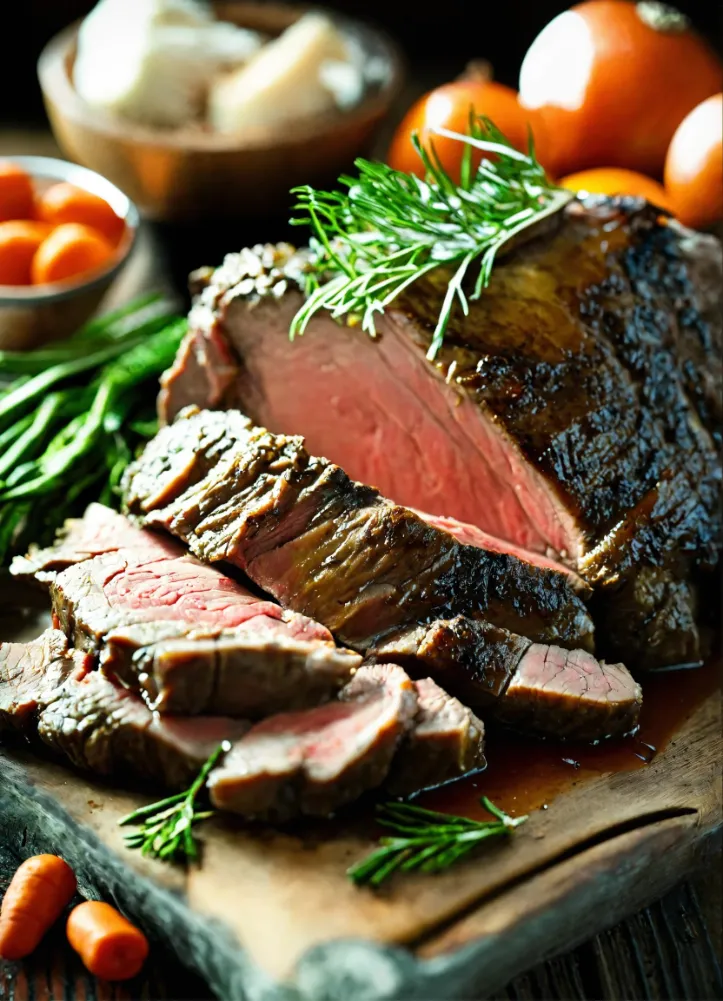Understanding Beef Shoulder Roast
Introduction to Beef Shoulder Roast
The beef shoulder roast, originating from the cow’s shoulder area, is celebrated for its robust flavor and tender texture. This cut, also known as the chuck roast, embodies a rich tapestry of culinary history, being a cornerstone in hearty stews, Sunday roasts, and slow-cooked barbecue delights. Its popularity stems from the cut’s versatility and ability to absorb flavors, making it a favored choice among chefs and home cooks alike. In culinary traditions, the beef shoulder roast signifies more than just a meal; it represents a communal experience, often associated with family gatherings and festive occasions, where its succulent, comforting presence takes center stage.
Selecting the Perfect Cut
Choosing the right beef shoulder roast is pivotal to achieving the perfect balance of flavor and tenderness. Here’s what to consider:
- Characteristics of Beef Shoulder Roast: This cut is known for its rich marbling and connective tissues, which break down during slow cooking to create a succulent and flavorful dish. It typically presents a hearty texture, making it ideal for braising, slow roasting, or stewing.
- Tips for Selecting the Best Cut:
- Look for roasts with a uniform shape for even cooking.
- Examine the marbling; fine threads of fat distributed throughout the muscle contribute to the meat’s moistness and flavor.
- Consider the color; fresh beef should have a bright red hue.
- Importance of Marbling and Trimming: Marbling is crucial for flavor and tenderness, as the fat melts during cooking, naturally basting the meat. However, excessive external fat should be trimmed to prevent the dish from becoming overly greasy. Proper trimming enhances the meat’s quality and ensures a balanced distribution of flavors, making the beef shoulder roast not just a meal, but a culinary experience worth savoring.
For a more detailed guide on selecting cuts, consider the resource “Understanding Beef Cuts” from BeefIt’sWhatsForDinner.
Preparation and Seasoning
Preparing a beef shoulder roast properly is crucial for optimizing its flavor and tenderness. The process begins with some essential steps to ensure the meat cooks evenly and absorbs the seasoning effectively.
How to Prepare Beef Shoulder Roast for Cooking
- Temperature Equalization: Begin by letting the roast come to room temperature before cooking. This step reduces the cooking time and helps in achieving even doneness.
- Trimming: While the roast will have been trimmed at the butcher’s, you might need to trim any excess fat, leaving about a quarter-inch layer to keep the meat moist during cooking.
- Patting Dry: Pat the surface of the roast dry with paper towels. This helps in forming a better crust when searing and allows the seasonings to stick to the meat better.
Seasoning Options and Marination Techniques
- Seasoning: Generously season the roast with salt and pepper. These basic seasonings enhance the natural flavors of the meat. For added depth, incorporate herbs like rosemary, thyme, or oregano, and spices like garlic powder, onion powder, or paprika.
- Marination: Marinating the beef shoulder roast can tenderize and infuse it with flavors. Combine ingredients like olive oil, vinegar, or lemon juice with your choice of herbs and spices. Place the roast in a marinating bag with the mixture and let it sit in the refrigerator for at least a few hours or overnight.
Pre-cooking Preparation Tips
- Searing: Before slow cooking, sear the roast on all sides in a hot pan with a bit of oil. This creates a flavorful crust and seals in the juices.
- Deglazing: After searing, deglaze the pan with a splash of wine, broth, or water, scraping up the browned bits. This liquid can be added to the cooking pot to enhance the roast’s flavor.
- Slow Cooking Prep: Prepare your slow cooker or roasting pan by layering the bottom with onions, carrots, and other root vegetables, which will serve as a natural rack and add flavor to the meat and cooking liquid.
By following these preparation and seasoning steps, you’ll ensure your beef shoulder roast is flavorful, tender, and delicious, setting the stage for a memorable culinary experience. For inspiration and creative uses of leftover roast, visit Taste of Home for a variety of recipes.
Cooking and Serving Beef Shoulder Roast
Cooking Techniques
Slow Roasting
Slow roasting is an excellent method for cooking beef shoulder roast, as it gently breaks down the tough fibers in the meat, resulting in a tender and flavorful dish.
- Procedure: Preheat your oven to a low temperature, around 275°F (135°C). Place the seasoned roast in a roasting pan, fat side up, to allow the fat to render and naturally baste the meat during cooking. Insert a meat thermometer into the thickest part of the roast, and cook until it reaches your desired level of doneness, typically several hours for a beef shoulder roast.
- Benefits: This method enhances the meat’s flavor and tenderness by allowing it to cook evenly and slowly. The low and slow process ensures that the roast retains its moisture, and connective tissues dissolve into gelatin, enriching the texture and taste.
Braising
Braising combines slow cooking with a moist environment, making it ideal for tenderizing tougher cuts of meat like the beef shoulder roast.
- Procedure: Start by searing the roast on all sides in a large pot or Dutch oven to develop a flavorful crust. Remove the roast and sauté some onions, garlic, and herbs in the same pot, adding depth to the flavors. Return the roast to the pot, add liquid (like beef broth, wine, or a combination) until it comes halfway up the meat, bring to a simmer, then cover and transfer to the oven. Cook at a low temperature (around 325°F or 160°C) until the meat is fork-tender.
- Benefits: Braising not only tenderizes the roast but also creates a rich, flavorful sauce as the cooking liquid reduces and melds with the meat’s juices. The resulting dish is succulent, with a complex flavor profile enhanced by the braising liquids and aromatics.
Grilling
Grilling imparts a smoky flavor and a unique char to the beef shoulder roast, making it an exciting alternative to traditional roasting methods.
- Procedure: Preheat your grill for indirect heat. Sear the roast on all sides over direct heat to develop a crust, then move it to the cooler part of the grill. Cover and grill, maintaining a steady temperature, until the meat reaches the desired internal temperature.
- Benefits: Grilling adds a smoky, charred flavor that can’t be replicated with other cooking methods. The high heat sears the exterior, locking in juices, while the slower indirect heat cooks the meat through, creating a flavorful and moist roast.
These cooking techniques offer different ways to enjoy beef shoulder roast, each with its unique advantages, whether you’re seeking tenderness, flavor, or a bit of outdoor grilling char.
Resting and Serving
Importance of Resting the Meat
Resting the beef shoulder roast after cooking is a critical step that should not be overlooked. This process allows the juices, which have been driven to the center of the meat during cooking, to redistribute throughout the roast. If sliced into immediately after cooking, these juices would run out, resulting in a drier, less flavorful piece of meat. Resting for 10 to 15 minutes lets the fibers of the meat relax and reabsorb the juices, ensuring that each slice is moist and succulent.
How to Slice and Serve for Optimal Taste
When it’s time to slice the roast, doing so against the grain of the meat fibers is key. This means cutting perpendicular to the direction of the muscle fibers, which shortens them and makes each slice more tender to chew. Use a sharp knife to make clean, even slices, ensuring that the meat retains its structure and juices.
For serving, the beef shoulder roast can be presented as the centerpiece of a meal, accompanied by sides like roasted vegetables, mashed potatoes, or a fresh salad. The juices collected during resting can be drizzled over the slices or made into a rich gravy to enhance the flavor further. This method of slicing and serving not only showcases the quality of the roast but also elevates the dining experience, making every bite a testament to the care and effort put into its preparation.
FAQs
Should you marinate the roast before cooking?
Marinating the beef shoulder roast is not mandatory, but it is highly recommended for enhancing flavor and tenderness. A marinade with vinegar or lemon juice tenderizes and flavors the roast. Marinate in the refrigerator for several hours or overnight to allow the meat to absorb the flavors fully.
Is searing necessary?
While not strictly necessary, searing the roast before slow cooking is beneficial. Searing forms a caramelized crust, seals in juices, and enhances flavor. This technique, known as the Maillard reaction, contributes to a more savory and appetizing final dish.
Recommended internal temperatures for doneness
For beef shoulder roast, the recommended internal temperatures are:
- 145°F (63°C) for medium-rare
- 160°F (71°C) for medium
- 170°F (77°C) or higher for well-done
Use a meat thermometer in the roast’s thickest part to ensure proper cooking.
Final Thoughts and Cooking Tips
Crafting the perfect beef shoulder roast is an art that combines patience, technique, and a bit of culinary intuition. In summary, choose a cut with balanced meat and fat for great taste and tenderness. Prep is key. Warm the roast, season well, and marinate to boost taste and texture.
When it comes to cooking, the method you choose will greatly affect the outcome. Slow roasting at low heat makes the meat tender and juicy. Braising adds flavor and richness. Grilling introduces a smoky nuance that can be particularly appealing during the warmer months. Sear the meat before slow cooking to deepen the dish’s flavor, no matter the method.
Let the roast rest post-cooking to redistribute juices, making each slice tender and tasty. When slicing, cutting against the grain will make the meat more tender and enjoyable to eat.
Cooking beef shoulder roast goes beyond recipes. It’s about connecting with the food and seeing how small tweaks affect the outcome. Don’t be afraid to experiment with different herbs, spices, and cooking methods to find what works best for you. Each attempt is an opportunity to refine your technique and discover new dimensions of flavor.
Ultimately, the journey to perfecting your beef shoulder roast is one of culinary exploration and discovery. Embrace the process, learn from each experience, and enjoy the delicious rewards of your labor. Your next roast might top all, showing your culinary growth and daring.
Explore more meat cooking tips in articles like “Introduction to Pot Roast Chicken“. And “Mastering the Art of Cheeseburger Egg Rolls”


